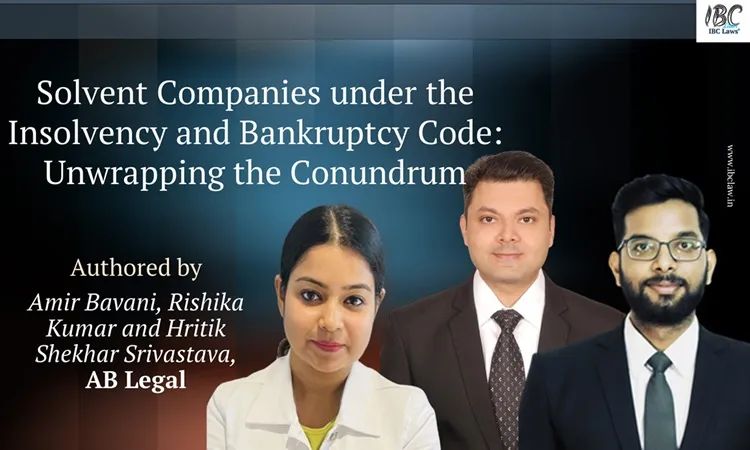Authored by: Amir Bavani, Founder, AB Legal Rishika Kumar, Senior Associate, AB Legal Anirban Aly Mandal, Associate, AB Legal
The Insolvency and Bankruptcy Code, 2016 (‘IBC/Code’) with passage of time, has seen several legislative amendments, which were introduced to improvise the insolvency & liquidation processes under the Code and advance its aims in line with growing market realities. There have also been many regulatory framework adjustments to simplify the implementation of processes under the Code. The Adjudicating Authority, Appellate Authority, High Courts, and Supreme Court have all passed significant rulings and judgements addressing various conceptual concerns, resolving controversial matters, and resolving grey situations. The Adjudicating and Appellate Authority’s interpretation of the legislation is a crucial component of the ecology around insolvency and bankruptcy. Through rules and the creation of the Code, the Tribunals and Courts are in-charge of solving the hurdles and further smoothening the process of insolvency and bankruptcy. Navigating the legal landscape of insolvency and bankruptcy can be overwhelming, especially when it comes to solvent companies. What exactly does it mean for a company to be solvent, and how does the Insolvency and Bankruptcy Code affect its operations? As we explore these questions, we’ll uncover essential insights and debunk common misconceptions. Throughout this article, we’ll shed light on how solvent companies cannot be admitted under Corporate Insolvency Resolution Process (‘CIRP’).
The Hon’ble Supreme Court has time and again observed that the fundamental intent of IBC is maximising the value of assets in the process of Resolution. In Mobilox Innovations Pvt. Ltd. Vs. Kirusa Software Pvt. Ltd. (2017) ibclaw.in 01 SC[1], the Hon’ble Apex Court has examined in detail the United Nations Legislative Guide on Insolvency[2], in which the IBC finds its roots. Any Application to commence CIRP can be denied when the Creditor is using the Code as an inappropriate substitute for debt recovery procedures. If IBC is purely used for the purpose of debt recovery, particularly when the amounts due are small, and the Company is a solvent entity and is a going concern, the question of Reorganising or Resolution of the Company does not arise.
Peer at Section 7 Applications
While considering the Corporate Debtor’s application for the initiation of CIRP under Section 7 of the IBC, 2016, the Adjudicating Authority is required to consider some other factors such as the reason for default, the Corporate Debtor’s financial health i.e., its potential to repay the loan. The Hon’ble Supreme Court in the matter of Vidarbha Industries Power Ltd. v. Axis Bank Ltd. (2022) ibclaw.in 91 SC, decided that in case of an application by the Financial Creditor, the Adjudicating Authority might examine the expedience of initiation of CIRP, taking into account all relevant facts including the overall financial health of the Corporate Debtor in following words:
“….81. The title “Insolvency and Bankruptcy Code” makes it amply clear that the statute deals with and/or tackles insolvency and bankruptcy. It is certainly not the object of the IBC to penalize solvent companies, temporarily defaulting in repayment of its financial debts, by initiation of CIRP. Section 7(5)(a) of the IBC, therefore, confers discretionary power on the Adjudicating Authority (NCLT) to admit an application of a Financial Creditor under Section 7 of the IBC for initiation of CIRP”.
The IBC aims to strike a balance between the interests of creditors, stakeholders, and the company undergoing financial distress. It provides a transparent and efficient mechanism for resolving insolvency cases, ensuring maximum recovery for creditors while preserving the value of the business. In another case of Anita Jindal Vs. Jindal Buildtech Pvt. Ltd. (2022) ibclaw.in 564 NCLAT [3], Hon’ble NCLAT, Principal Bench, has analysed that the main issue which arises for consideration in this Appeal is whether the Section 7 Application admitted against a Solvent Company, in the background where the Company has issued two cheques as security for the amount lent, and one cheque amount has been paid and for the balance second cheque amount, does the initiation of Insolvency Proceedings fall within the ambit of the scope, objective and spirit of the Code which is ‘Resolution’ and not ‘Recovery’? Wherein, the Adjudicating Authority admitted the CIRP qua Corporate Debtor. Deciding this very issue, the Hon’ble Appellate Tribunal allowed the appeal and held that:
“17. This Tribunal is of the ernest view that seeking to initiate CIRP, in the factual matrix of the attendant case, is only with an intention for ‘Recovery’ of their dues and opposes the very spirit, point and purpose of the Code. We hold that ‘A Recovery Proceeding’ of this nature does fall within the scope and ambit of the words ‘for any purpose other than Resolution’, as defined under Section 65 (1) of the Code. Having regard to the facts and circumstances of the case on hand, this Appeal is allowed and the Order of the Adjudicating Authority is set aside.”
In another case of HDFC Bank Vs. John Energy Ltd.[4] Hon’ble NCLT, Ahmedabad Bench, observed that a viable company capable of repaying its debt cannot be admitted into the CIRP solely at the request of a single Financial Creditor, which holds 10% of the total outstanding debt. The Hon’ble Tribunal held that:
“21. …the Corporate Debtor is a viable company and it can pay its debt or it cannot be admitted in CIRP at the instance of only one Financial Creditor having debt 10% of total outstanding payable by the Corporate Debtor. We put on record that the other lenders are ready to cooperate with the Corporate Debtor to pull itself out of the debt trap. Only HDFC Bank wants us to admit the Corporate Debtor in CIRP for their own reasons which we do not wish to endorse.
22. So, on considering all the above facts, and more particularly, the Corporate Debtor has in its hand the contracts worth of Rs.711.18 Crores whereas total debt payable to HDFC Bank is Rs. 86.21 Crores and other lenders are ready to restructure the loan, we hold that it is not proper on our part to admit the Corporate Debtor in CIRP at once at this stage.”
Peer at Section 9 Application
In this backdrop, the Hon’ble Supreme Court has time and again held that the provisions of IBC cannot be used as a means to recover dues. Earlier, under the Companies Act, the courts tested the solvency of the Corporate Debtor and its ability to pay its debt, the test is limited to the existence of a debt and a default, and not a pre-existing dispute between the parties. It has been made very explicit by Tribunals and Courts that insolvency should not be initiated to chastise the solvent companies for non-payment of disputed dues as claimed by the operational creditor, as the same is against the intent and object of the code.
In one Judgement, i.e., Tricolite Electrical Industries Limited Vs WIPRO Ltd. (2023) ibclaw.in 575 NCLAT[5], Hon’ble NCLAT, Chennai Bench while adjudicating the case has considered the issue that is whether the Adjudicating Authority was justified in dismissing the Section 9 Application on the ground of pre-existing dispute and that the Respondent Company was a Commercially Solvent Company? Whereby the Adjudicating Authority had dismissed the Application filed under Section 9 of the Code. The Hon’ble Appellate Tribunal dismissed the appeal and held that:
“16. …this Tribunal is of the considered view that there is a pre-existing dispute which is not a spurious defence which is a mere bluster.
Regarding whether Section 9 Application can be entertained against a Solvent Company, the scope and objective of the Code has to be kept in mind before admission of such an Application. The spirit of the Code is maximization of the assets and Resolution and not Recovery. The Hon’ble Supreme Court in the matter of ‘Swiss Ribbons Pvt. Ltd. & Anr. Vs. Union of India & Anr.’ (Supra) has held that ‘the primary focus of the legislation is to ensure revival and continuation of the corporate debtor by protecting the corporate debtor from its own management and from a corporate death by liquidation. The Code is thus a beneficial legislation which puts the corporate debtor back on its feet, not being a mere recovery legislation for creditors.’”
In another Judgement of Sterling and Wilson Pvt. Ltd. Vs Embassy Energy Pvt. Ltd. (2023) ibclaw.in 406 NCLAT [6], Hon’ble NCLAT, Chennai Bench while adjudicating the case has held that Section 9 application qua a solvent company is not allowable. The Hon’ble Appellate Tribunal dismissed the appeal and held that:
“We are also conscious of the fact that the ‘Respondent’ is a commercially solvent Company and the scope and objective of the Code is not to send a commercially ‘Solvent Company’ to ‘Insolvency’ specifically having regard to the facts of the attendant case on hand.”
Read the full article HERE.





